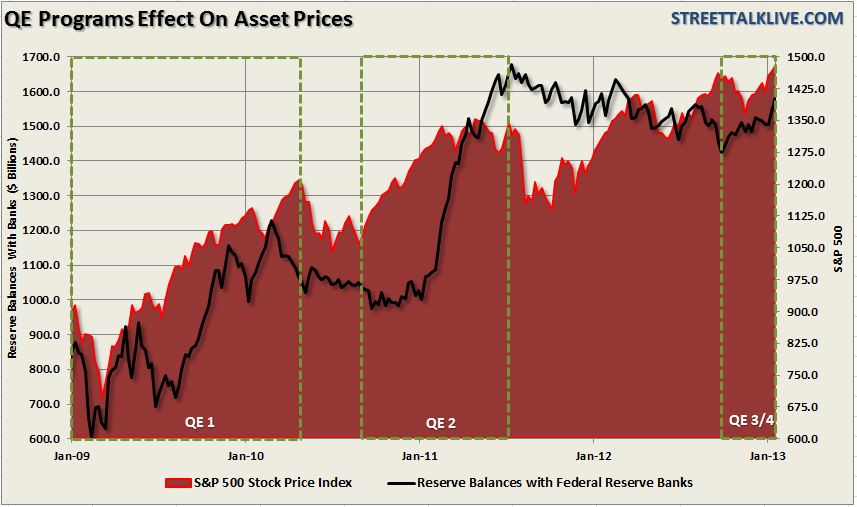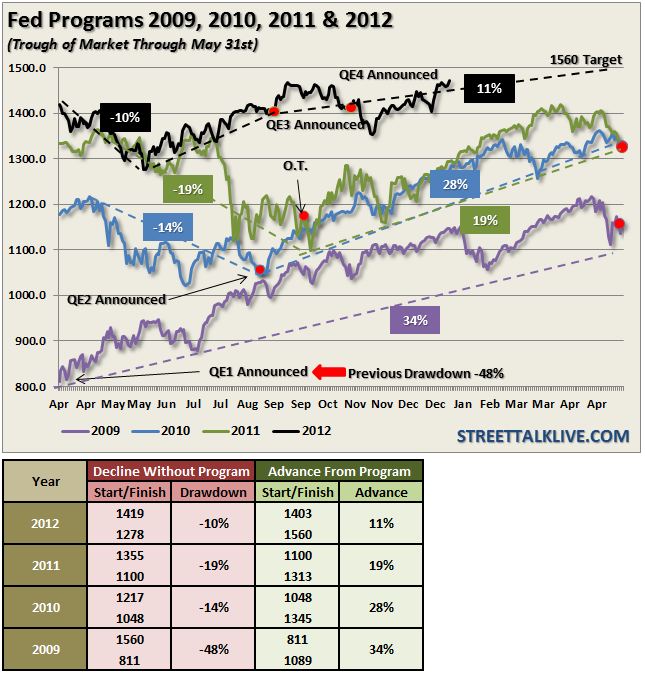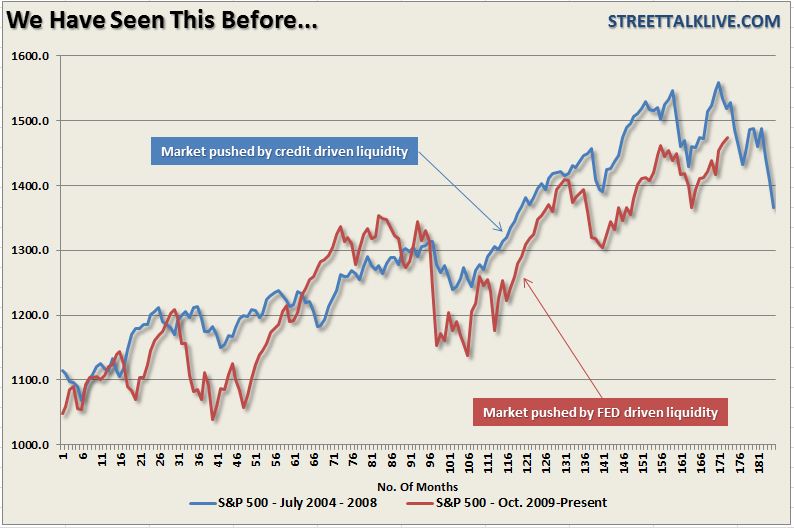There has been an burst of exuberance as of late as the market, after four arduous years, got back to its pre-crisis levels. Much has been attributed to the recent burst of optimism in the financial markets from:
1) Better than expected earnings - not counting the fact that expectations had been dramatically lowered over the last quarter. If you lower the bar enough you will get better results. However, if expectations levels had remained where they were previously every single report would have missed so far.
2) Stronger economic growth ahead - expectations are once again, as we have seen over the last 3 years, that the economy will grow at 3% or better in the coming year. Unfortunately, most of the economic data suggests that 2013 will remain mired closer to 2% after a very lackluster first half of the year.
3) The end of the bond bubble is near - like the economy; bond bears have been calling for the end of bond bubble. Will 2013 be the year? Most likely not as the chase for yield continues as masses of baby boomers move into retirement needing income to maintain their standard of living.
4) The long term outlook is getting better - this is true but how much of the long term outlook is already priced in? How much of the long term outlook is due to artificial stimulus versus organic economic growth?
5) Valuations are cheap - the argument of cheap valuations is a hollow one. First, comparing forward operating earnings expectations to trailing reported GAAP earnings is apples and oranges. Using the Shiller 10-year median P/E - valuations are at levels normally associated with bull market peaks. Secondly, the argument of earnings yield compared to bond yields is garbage. Bond yields are being artificially suppressed which distorts the argument from reality. Furthermore, investors do not receive the earnings yield from stocks but they DO receive the interest income from bonds.
6) The great rotation is here - for the third year in a row we are once again hearing that the "mountains of cash" piled on the sidelines is about to flow into the markets. That has yet to happen and there is little indication as of yet that 2013 will be any different.
The point to made here is that each time the market has rallied the media, and analysts, try to attribute the rally to a fundamental support. In most cases the arguments boil down to "hope" more than "reality." However, what is really driving the current rally is likely far more simplistic: $85 billion a month.
With the Federal Reserve currently engaged in two simultaneous quantitative easing programs (QE 3 and 4) totaling $85 billion a month in purchases of both mortgage backed and treasury bonds - the excess reserve accounts of the banks have soared in recent weeks. There is a very high historical correlation (85%) between the expansion of the Fed's balance sheet and the stock market.
The chart below shows the relationship between the financial market and the expansion/contraction of excess reserves held by banks. Historically, these excess reserves, prior to 2008, averaged about 18.9 billion. Today those excess reserves amount to $1.58 Trillion. 
Each market rally is always expected to continue indefinitely into the future. The reality is that this is never the case and that the inevitable correction is always completely "unexpected." The current rally, as shown in the next chart and table, will likely proceed along the same course as we have seen with each previous QE program. Our current target for the rally is 1560 on the S&P 500 which would be an 11% return from the start of QE3. Should this target be reached it will continue the pattern of diminished rates of return as these liquidity driven surges have become more fully priced into the markets. 
It is clear that the visible hand of the Federal Reserve is firmly in control of the markets at the moment as liquidity flows are increased. However, extrapolating the current advance indefinitely into the future becomes somewhat dangerous. Each previous program cycle has ended with a fairly nasty decline, in both the markets and the economy, as the fundamental drivers were being supported solely by artificial interventions. Those declines would have likely been far worse had they not been halted by the next round of "liquidity injected goodness."
While the Fed programs that we have witnessed since the financial crisis are historically unique - liquidity driven markets are not. We have witnessed the effects of excess liquidity in the bull market cycle prior to the 2008 financial crisis. The only difference during that cycle was that, through government intervention, real estate was turned into an ATM allowing mortgage equity withdrawals to be the liquidity source for the economy and the markets. The chart below shows the extremely high correlation between these two bull market cycles. 
There are many similarities between the peak of the market in 2008 and today. Investor sentiment is pushing extreme levels, the markets are exceedingly overbought, earnings are weakening, complacency is higher, multiples are expanding, the consumer is beginning to sputter and headlines are beginning to push the boundaries of manic optimism.
One doesn't haven't to think back too far to remember that at the peak of the markets in 2008 there was no recession in sight, even though it had already started, as it was a "goldilocks" economy. Earnings were expected to continue to grow into the coming year and equities were the only investment of choice. Come to think of it - that is what we heard in 1999 as well.
David Rosenberg summed this up well in his most recent missive:
"As imperfect souls, we as human beings simply don't see that the existing situation will somehow be resolved and come to an end, and that in the ensuing three to five years, we will either be belly aching over a new bear market or celebrating a bull phase. And in either case, it's called 'living in the moment.' But the most dangerous thing anyone can do is extrapolate the most recent experience, as enduring as it may seem, into the future. Good, bad or indifferent, we will be talking about something completely different three to five years from now than we have been for the past number of years."
The point here is that there are times when one should step back to look at the forest for the trees. The catalysts that brought the financial markets to its knees in 2000-2002 or 2008-2009 will likely not be the same ones in the future. Will the markets continue to play out as the chart above potentially forecasts? I haven't a clue. With the Fed fully engaged in stimulus programs domestically, as well as the ECB and Japan globally, there is excess liquidity sloshing throughout the financial system. The market rally could well rise farther, for longer, than most would expect possible.
The current belief is that the central banks will have the foresight to withdraw the stimulus before the next bubble is formed, unfortunately, there is no historical precedent that supports that claim. However, with the markets fully inflated, we have reached the point that where even a small exogenous shock will likely have an exaggerated effect on the markets. There are times that investors can safely "buy and hold" investments - this likely isn't one of them.
- English (UK)
- English (India)
- English (Canada)
- English (Australia)
- English (South Africa)
- English (Philippines)
- English (Nigeria)
- Deutsch
- Español (España)
- Español (México)
- Français
- Italiano
- Nederlands
- Português (Portugal)
- Polski
- Português (Brasil)
- Русский
- Türkçe
- العربية
- Ελληνικά
- Svenska
- Suomi
- עברית
- 日本語
- 한국어
- 简体中文
- 繁體中文
- Bahasa Indonesia
- Bahasa Melayu
- ไทย
- Tiếng Việt
- हिंदी
The Visible Hand Of The Fed
Published 01/25/2013, 02:59 AM
Updated 02/15/2024, 03:10 AM
The Visible Hand Of The Fed
Latest comments
Loading next article…
Install Our App
Risk Disclosure: Trading in financial instruments and/or cryptocurrencies involves high risks including the risk of losing some, or all, of your investment amount, and may not be suitable for all investors. Prices of cryptocurrencies are extremely volatile and may be affected by external factors such as financial, regulatory or political events. Trading on margin increases the financial risks.
Before deciding to trade in financial instrument or cryptocurrencies you should be fully informed of the risks and costs associated with trading the financial markets, carefully consider your investment objectives, level of experience, and risk appetite, and seek professional advice where needed.
Fusion Media would like to remind you that the data contained in this website is not necessarily real-time nor accurate. The data and prices on the website are not necessarily provided by any market or exchange, but may be provided by market makers, and so prices may not be accurate and may differ from the actual price at any given market, meaning prices are indicative and not appropriate for trading purposes. Fusion Media and any provider of the data contained in this website will not accept liability for any loss or damage as a result of your trading, or your reliance on the information contained within this website.
It is prohibited to use, store, reproduce, display, modify, transmit or distribute the data contained in this website without the explicit prior written permission of Fusion Media and/or the data provider. All intellectual property rights are reserved by the providers and/or the exchange providing the data contained in this website.
Fusion Media may be compensated by the advertisers that appear on the website, based on your interaction with the advertisements or advertisers.
Before deciding to trade in financial instrument or cryptocurrencies you should be fully informed of the risks and costs associated with trading the financial markets, carefully consider your investment objectives, level of experience, and risk appetite, and seek professional advice where needed.
Fusion Media would like to remind you that the data contained in this website is not necessarily real-time nor accurate. The data and prices on the website are not necessarily provided by any market or exchange, but may be provided by market makers, and so prices may not be accurate and may differ from the actual price at any given market, meaning prices are indicative and not appropriate for trading purposes. Fusion Media and any provider of the data contained in this website will not accept liability for any loss or damage as a result of your trading, or your reliance on the information contained within this website.
It is prohibited to use, store, reproduce, display, modify, transmit or distribute the data contained in this website without the explicit prior written permission of Fusion Media and/or the data provider. All intellectual property rights are reserved by the providers and/or the exchange providing the data contained in this website.
Fusion Media may be compensated by the advertisers that appear on the website, based on your interaction with the advertisements or advertisers.
© 2007-2024 - Fusion Media Limited. All Rights Reserved.
